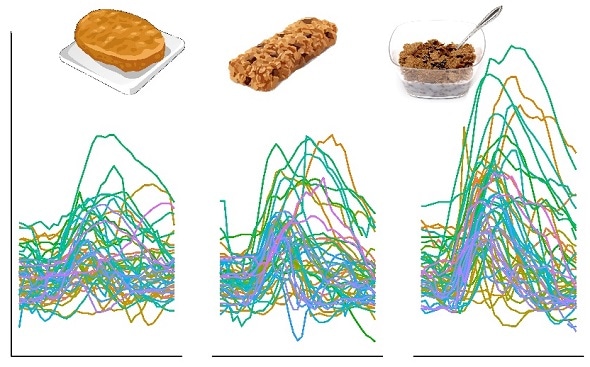Jul 26 2018
Food has a major impact on glucose fluctuations and certain commonly eaten foods were found to cause a large glucose spike in most participants.
The amount of glucose circulating in the blood changes throughout the day and night and it is influenced by the food we eat, activity, hormones, health, and more. It is well known that glucose levels above or below certain thresholds can cause damage to organs; however, a new study publishing 24 July in the open access journal PLOS Biology by researchers at Stanford University reveals that “normal” blood glucose levels are often not normal at all—they stray much farther from the healthy ranges than we assumed.

Food has a major impact on glucose fluctuations and certain commonly eaten foods were found to cause a large glucose spike in most participants. Credit: pbio.2005143 and Pixabay
The most common way to measure blood glucose is by testing a fasting blood sample which will reveal the level at that particular point in time. Another common way is to test levels of glycated haemoglobin, “HbA1C,” which reflects average blood glucose for the last 3 months. Unfortunately, neither of these measurements reveals the dynamic changes that occur throughout the day. More recently, continuous glucose monitors — relatively new devices — have been used by some patients with diabetes to understand these daily variations.
In the new study, however, continuous glucose monitoring in healthy participants showed that large fluctuations in blood glucose happen much more commonly than expected. When looking at the glucose “spikes” from 57 study participants, the authors found that people can be classified into 3 distinct “glucotypes” or glucose behaviors: those whose glucose does not vary much (low), those who spike often (severe), and those in between (moderate).
To assess how different people react to the same meal, the team provided three different standardized breakfasts to study participants: corn flakes with milk, bread with peanut butter, and a nutrition bar. The individual responses to these meals were unique, suggesting that people metabolize the same nutrients in an individualized way. Certain commonly eaten foods such as corn flakes were also found to cause a large glucose spike in most participants. As food has a major impact on glucose fluctuations, the team is building models to predict the foods that personally affect each individual.
“We were very surprised to see blood sugar in the prediabetic and diabetic range in these people so frequently” said Michael Snyder, PhD, Professor and Chair of Genetics at Stanford and senior author of the study. “The idea is to try to find out what makes someone a “spiker” and be able to give them actionable advice to shift them into the low glucotype.”
“Our next study will delve into the physiological causes of glucose dysregulation” Snyder continued. “These include not only genetic variation, but also microbiome composition, and pancreas, liver, and digestive organ functions.” In this manner the Stanford team hope to better control glucose dysregulation and prevent diabetes and its associated complications such as cardiovascular disease.